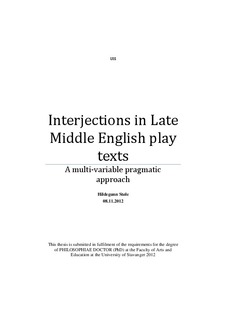| dc.description.abstract | This thesis aims at providing a multidisciplinary in-depth analysis of interjections in Late Middle English play texts. The starting point of the study is historical pragmatics, but it is believed that many variables must be taken into account when linguistic items from text types of long past historical eras are examined. This is particularly true of interjections, which in many ways traverse the boundary between the spoken and the written modes, and of Late Middle English play texts. On one hand, plays may belong to the text type closest to the spoken mode, yet, on the other hand, the Middle English plays include some features quite foreign to speech, e.g. versification. The study is an empirical one, and it employs both qualitative and quantitative methods in the analysis of historical interjections. It is hoped that this study can contribute something to both the fields of literature and of historical linguistics.
Chapter 1 introduces the topic by discussing speech and writing, as well as historical features which one needs bear in mind when studying past stages of language. It also presents the types of drama the study explores.
Chapter 2 explicates relevant theory, the research questions, and discusses definitions of both interjections and play texts. It further discusses historical pragmatics and pragmatics in, general pragmatics, and historical linguistics, including dialectology, and it presents two modern approaches applicable to the language of play texts. An overview of the literature on historical interjections is also provided.
Chapter 3 discusses the multi-contextual background to interjections in Late Middle English play texts. It discusses dialect, scribal transmission, and the religious, social, and cultural history behind the mainly religious play texts providing the data for the corpus developed as part of the present study. Chapter 3 also provides collations of the few texts surviving in more than one manuscript, in order to establish whether there seems to be a pattern for how scribes treated interjection, specifically whether they treated them as meaningful words or as meaningless sounds. The problem of categorising Late Middle English play texts is also discussed. The categories commonly used to describe these texts are in the main modern conventions, and, therefore, alternative categories are suggested.
Chapter 4 discusses the methodology and the selection and treatment of the data. This chapter provides a presentation of the database developed for the purposes of the present study. Questions concerning the database, its fields, and the interpretation of the data entered into it, are discussed simultaneously as the database is described. A typical entry in the database is exemplified in Table 4-1on p. 159.
Chapter 5 lists the play texts with manuscript repositories and SCT numbers of the printed texts. The chapter contains descriptive information concerning date of copy, number of hands, dialect, and subgenre. Appendix 1 complements Chapter 5 by giving more detail about, for instance, dramatis personae, stage directions, and likely manner of staging.
Chapter 6 discusses each interjection type qualitatively, before some promising findings are compared and discussed in greater detail towards the end of the chapter. Such findings include whether dialect can explain some of the spelling variation found in certain types of interjections, and whether certain play texts exhibit any particular patterns in their use of types and numbers of interjections. The definition of interjections is revisited in Chapter 6 in light of the empirically-based results of the analyses of the actual use of interjections in Late Middle English play texts.
In Chapter 7 some selected items and findings are subjected to statistical analysis. Significance testing is applied to some results, but it is restricted to the sort of findings which can be validly tested in groups of data of rather disparate qualities. It is e.g. difficult to perform a valid significance test of the frequencies of certain interjections in dialect groups consisting of different types of material from different dates.
Chapters 8 and 9 consist of short discussions and conclusions, respectively. Only the main findings are summarised in Chapter 8, and Chapter 9 discusses potential problems and suggests topics for future studies. | no_NO |
